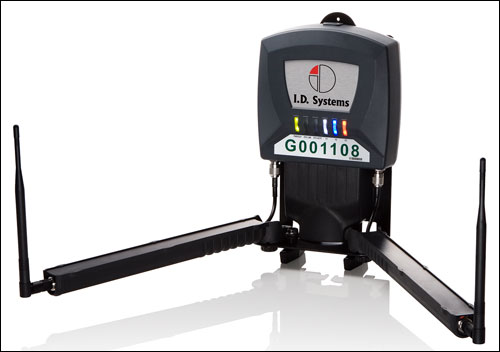After a yearlong trial using radio frequency identification technology installed within 5,000 rental cars at parking lots of its corporate clients, as well as at a major airport, Avis Rent A Car is launching a U.S.- and Canada-wide deployment of its Avis On Location system, enabling customers to access and then return Avis rental cars without having to submit the usual paperwork and spend time at a manned desk. The system will allow corporate customers that frequently rent cars to set up rental areas within their own parking lots.
The RFID technology, provided by vehicle-management solutions company I.D. Systems, consists of an ultrahigh-frequency (UHF) RFID transceiver, known as a Wireless Asset Manager (WAM), that is wired to a 110-volt AC power source, and a Motor Vehicle Asset Communicator (MVAC) device installed in the car and powered by the vehicle’s battery. The MVAC receives and transmits RFID data, and also controls the car door’s locking mechanism, tracking the vehicle’s mileage and fuel consumption. Although the WAM is hard-wired for power, it contains a backup battery for memory storage in the event of a power loss. Both the WAM and MVAC devices can capture and send data via RFID. While the WAM transmits an ID number to the vehicle’s MVAC in order to trigger the unlocking of the doors, the MVAC does more than just send information—it also includes a data logger. While the vehicle is being driven, the MVAC measures the mileage and gas consumption, and then stores that data. When interrogated by the WAM as the vehicle is returned, the MVAC transmits those measured details, along with its unique ID.
By using the technology, Avis can quickly set up rental-lot areas in company parking lots, and customers can access and return the cars, and then be billed accordingly, all using their smart phones. The solution is designed to enable rental cars to be made available at locations at which they were never before offered. Some companies that rent a large number of vehicles for their employees could establish a new automated Avis On Location rental lot in their own parking area, while the system could also be utilized at airports, enabling users to complete the rental process online, and to access the car at an airport location by using a PIN provided via mobile phone. In this case, users would not need to fill out paperwork or retrieve car keys from the agency’s staff.
The project’s focus is on enabling the establishment of such remote “virtual” rental locations, according to Alice Pereira, a spokesperson for Avis Budget Group. “Avis On Location saves customers time,” she explains, “because we can offer corporate customers a rental location on their property, and their employees don’t need to travel to a nearby airport, or Avis or Budget location, to access a rental car.” Within lots or at an airport, Pereira adds, “the time from program signup to rental is much shorter” than a traditional rental process, and enrollment is handled entirely online.
A driver wishing to rent a vehicle from one of these so-called virtual lots would first visit Avis’ Web site and reserve a vehicle, indicating the lot at which he or she plans to pick it up. After completing the form, the customer receives a PIN for use in accessing the car. The data is managed by Avis Budget’s Wizard Reservation system, which also determines which vehicle particular that the user would access on the lot.
Once the driver has completed the online registration process and received a PIN specific to that rental transaction, he or she arrives at the lot and can then use a cell phone to send the PIN to Avis’ Web site, in order to access the car. That data is retrieved by I.D. Systems software, which signals approval, via a cellular connection, to a WAM RFID transceiver located on that lot. Typically, says Greg Smith, I.D. Systems’ VP, the WAM transmitter would be installed on a pole or wall somewhere within the lot area; because it has a read range of up to a half mile, he notes, only one device per lot is required. Upon receiving approval for access to that specific car, the device then transmits data including the unique ID number of an MVAC installed under the vehicle’s dashboard. After receiving that 900 MHz UHF transmission, the MVAC triggers the unlocking of the driver’s-side door.
The individual can then simply open the door handle and find the ignition key inside. The MVAC device installed in the car does more than just transmit data and unlock doors, however—it also tracks the vehicle’s usage, monitoring the number of miles that the car travels before being returned, as well as the amount of fuel consumed and replenished. Once the car is returned to a lot—which need not necessarily occur at the same lot of origin—the WAM device captures the unique ID and other measurement data from the vehicle’s MVAC device.
The WAM device employs a cellular connection to transmit that information to a back-end server, where the data is interpreted by I.D. Systems software and is then made available to the Avis system. The rental company can then bill accordingly for the vehicle’s usage.
The solution was initially piloted using vehicles at multiple locations throughout the Northwest—one at a major airport, Smith says, and several others at the parking lots of various companies using Avis rental cars. “We were extremely happy with the pilot tests,” Pereira says. “Avis On Location, based on many months of pilot tests… is able to provide the most scalable, flexible and customer-friendly solution ever offered. These attributes required extensive testing and development, and we believe Avis On Location now represents the best-in-class solution for providing corporate customers with an on-site rental-car service.”
Initially, Avis intends to equip 25,000 of its vehicles in the United States and Canada—though primarily in the United States—and to begin providing virtual on-location services that could be used with just a few cars, or with hundreds. “It is designed to be a very flexible, rapidly deployable system,” Smith states. Companies are currently trending toward providing rental cars to employees for travel during the workday, Avis reports—in some cases, to encourage workers to use mass transportation from home (they could access the rental vehicles during the day, if necessary).
Eventually, the company says it hopes to offer the system worldwide.



